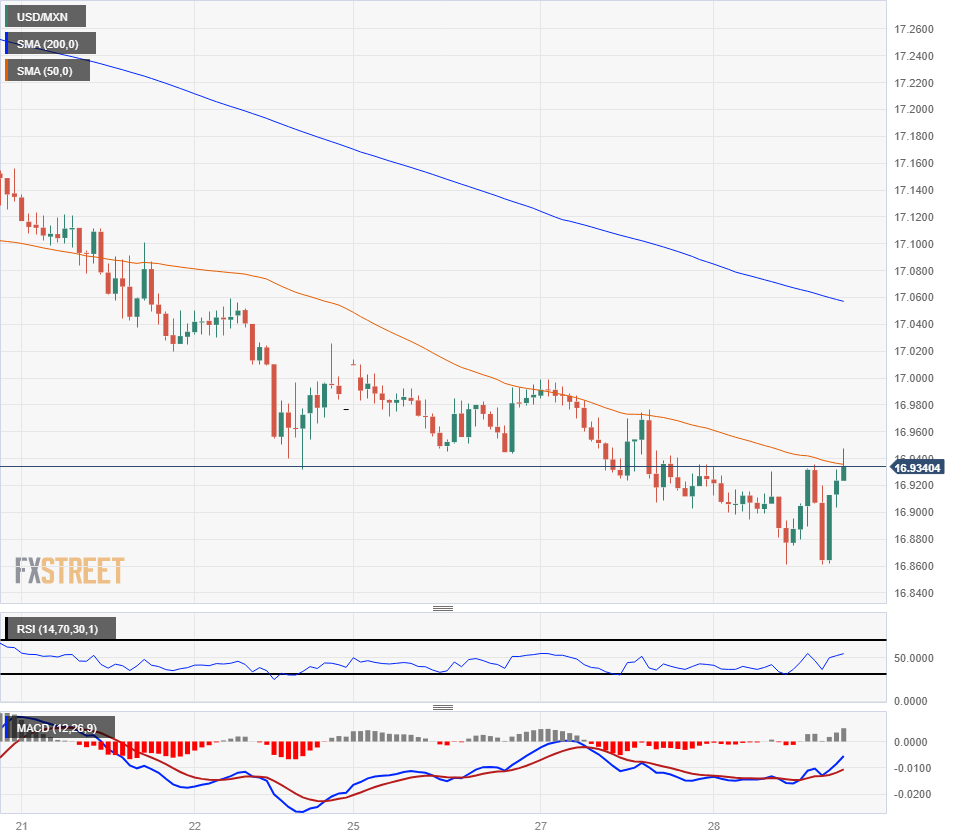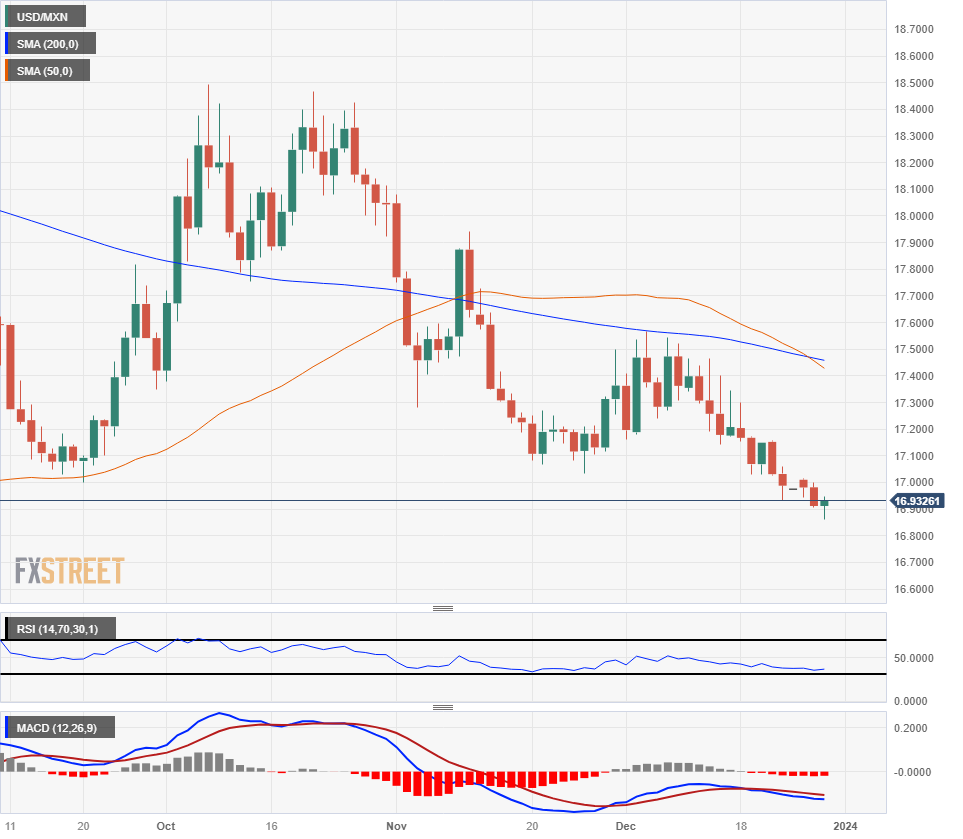Mexican Peso spreads on Thursday, hitting fresh highs before falling back into familiar levels

- The Mexican Peso gains further ground as the US Dollar selloff continues.
- Mexico’s Jobless Rate stays unchanged in November, US Jobless Claims climbed last week.
- Coming up on Friday: US Chicago PMI, Mexico Fiscal Balance.
The Mexican Peso (MXN) continued to climb through the penultimate trading day of 2023 before falling once more as broad-market US Dollar flows dictate the general direction of the FX market. A thin trading week between two market holidays is seeing some rough chop as speculators churn USD flows in thin market volumes to round out the 2023 trading year.
Despite a late topside break for the USD, the MXN is poised for a third straight week of gains against the US Dollar as the Greenback faces broad-market selling pressure.
Mexico’s unadjusted Jobless Rate held steady in November, thumbing its nose at market expectations of a minor decline, though the seasonally adjusted figure ticked higher. On the US side, Initial Jobless Claims and Pending Home Sales both missed expectations to come in worse than expected. With US data softening at the print, bad news is good news in topsy-turvy markets that are looking for accelerated rate cuts from the Federal Reserve (Fed).
Daily digest market movers: Mexican Peso hits fresh 16-week as Greenback continues to backslide
- The Mexican Peso is up around 0.3% against the US Dollar on Thursday, gaining 0.8% from the week’s opening bids.
- Broad-market USD selling pressure is bolstering the Peso, with the US Dollar the single worst-performing of the majors, in the red across the board for the last trading week of the year.
- Mexico’s unadjusted Jobless Rate held steady at 2.7% in November versus the forecast tickdown to 2.6%, though the seasonally-adjusted figure showed a slight jump to 2.8%.
- US Initial Jobless Claims jumped to 218K for the week ended December 22, vaulting over the forecast 210K and pushing even higher from the previous week’s 206K (revised upwards from 205K).
- US Pending Home Sales in November also failed to recover as much ground as forecasts expected, printing at a flat 0.0% compared to a forecast 1.0% gain; October’s print of -1.2% was revised slightly upwards from -1.5%.
- Friday will round out the 2023 trading year with the US Chicago Purchasing Managers’ Index for December, forecast to decline from 55.8 to 51.0.
- Mexico’s Fiscal Balance in Peso terms for November will wrap up the year’s economic data prints from Mexico. The Secretaría de Hacienda y Crédito Público, Mexico’s finance ministry, last printed a MXN 29.58 billion deficit in October.
US Dollar price this week
The table below shows the percentage change of US Dollar (USD) against listed major currencies this week. US Dollar was the strongest against the Pound Sterling.
| USD | EUR | GBP | CAD | AUD | JPY | NZD | CHF | |
| USD | -0.35% | -0.09% | -0.36% | -0.57% | -0.75% | -0.64% | -1.68% | |
| EUR | 0.43% | 0.27% | 0.11% | -0.15% | -0.39% | -0.21% | -1.25% | |
| GBP | 0.22% | -0.35% | 0.00% | -0.47% | -0.69% | -0.37% | -1.74% | |
| CAD | 0.36% | -0.30% | 0.21% | -0.47% | -0.40% | -0.12% | -1.47% | |
| AUD | 0.57% | 0.15% | 0.47% | 0.21% | -0.22% | -0.02% | -1.29% | |
| JPY | 0.75% | 0.43% | 0.48% | 0.68% | 0.21% | 0.31% | -1.09% | |
| NZD | 0.64% | 0.23% | 0.57% | 0.28% | 0.03% | -0.19% | -1.00% | |
| CHF | 1.84% | 1.21% | 1.40% | 1.46% | 1.33% | 1.07% | 1.06% |
The heat map shows percentage changes of major currencies against each other. The base currency is picked from the left column, while the quote currency is picked from the top row. For example, if you pick the Euro from the left column and move along the horizontal line to the Japanese Yen, the percentage change displayed in the box will represent EUR (base)/JPY (quote).
Technical Analysis: Mexican Peso stretching for further gains to wrap up the year, USD/MXN sinks in rough trading
The Mexican Peso (MXN) climbed to a fresh 16-week high against the US Dollar on Thursday, sending the USD/MXN to a multi-month low of 16.86. The pair has steadily declined through the shortened trading week and fell nearly a full percent peak-to-trough before a broad-market rebound in the US Dollar across the broader market space.
The USD/MXN is poised to close in the red for the third straight week and is set to close December in the red as well, rounding out one of the US Dollar’s worst-performing years against the Peso to date, closing lower for 9 of the past 12 straight months.
Ongoing selling pressure has brought the USD/MXN within multi-year lows near 16.60, and a break below this level would mark the pair’s weakest bids since December 2015.
On the high side, the 200-day Simple Moving Average (SMA) is parked near 17.45, and bearish cross of the 50-day SMA is chalking in a long-term resistance barrier to cap off any bullish reversals.
USD/MXN Hourly Chart
USD/MXN Daily Chart

US Dollar FAQs
The US Dollar (USD) is the official currency of the United States of America, and the ‘de facto’ currency of a significant number of other countries where it is found in circulation alongside local notes. It is the most heavily traded currency in the world, accounting for over 88% of all global foreign exchange turnover, or an average of $6.6 trillion in transactions per day, according to data from 2022.
Following the second world war, the USD took over from the British Pound as the world’s reserve currency. For most of its history, the US Dollar was backed by Gold, until the Bretton Woods Agreement in 1971 when the Gold Standard went away.
The most important single factor impacting on the value of the US Dollar is monetary policy, which is shaped by the Federal Reserve (Fed). The Fed has two mandates: to achieve price stability (control inflation) and foster full employment. Its primary tool to achieve these two goals is by adjusting interest rates.
When prices are rising too quickly and inflation is above the Fed’s 2% target, the Fed will raise rates, which helps the USD value. When inflation falls below 2% or the Unemployment Rate is too high, the Fed may lower interest rates, which weighs on the Greenback.
In extreme situations, the Federal Reserve can also print more Dollars and enact quantitative easing (QE). QE is the process by which the Fed substantially increases the flow of credit in a stuck financial system.
It is a non-standard policy measure used when credit has dried up because banks will not lend to each other (out of the fear of counterparty default). It is a last resort when simply lowering interest rates is unlikely to achieve the necessary result. It was the Fed’s weapon of choice to combat the credit crunch that occurred during the Great Financial Crisis in 2008. It involves the Fed printing more Dollars and using them to buy US government bonds predominantly from financial institutions. QE usually leads to a weaker US Dollar.
Quantitative tightening (QT) is the reverse process whereby the Federal Reserve stops buying bonds from financial institutions and does not reinvest the principal from the bonds it holds maturing in new purchases. It is usually positive for the US Dollar.
